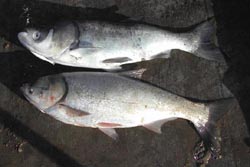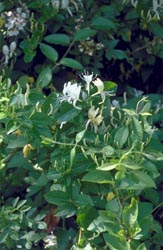-May 2006-
Aliens From Earth
“Exotic" or "alien" species are those organisms that are introduced to land or water that is not their native habitat. Alien species are identified as "invasive" or "nuisance" when their presence in a non-native habitat causes environmental or economic damage. Invasive species were introduced into the Great Lakes as early as the 1860s. Time has been on their side; as water related commercial and recreation activities have increased, so have the opportunities for introductions of more species into Illinois’ rivers and lakes. The scale of introduction can range from the release of ship ballast water to a recreational boat or fishing equipment that is not properly cleaned after use.
A 2004 report by the Global Invasive Species Programme estimates that inland water species are becoming extinct at a rate five times faster than the rate for terrestrial species.* The report also states that invasive species are the primary cause of endangerment to, or extinction of, freshwater species. Invasive species are costly to the environment and economy of Illinois. Eradication and management of invasives costs the state millions of dollars each year. Other economic costs include the disruption of recreational and commercial fishing and damage to water related structures such as pipes. The environmental costs are even more serious as they are measured in the loss and severe degradation of native habitat that cannot be completely restored and species that cannot be replaced once they are extinct
Biological characteristics of Illinois invasive species enable them to survive in non-native habitats, as well as spread quickly on land or in water. Zebra mussels can filter 300,000 times the concentration amount of a substance (including pollutants) in the water. This extraordinary filtering capability means that they also filter and feed on huge quantities of aquatic organisms that are a food source for native species. Zebra mussels can reproduce in their second year, laying 40,000 eggs in one reproductive cycle and a million eggs during one spawning season. Once they reach the juvenile stage, they attach themselves to a surface, which could be a pipe, a native mussel, or even an aquatic plant, in order to form colonies.
 Like the zebra mussel, the Asian carp is a voracious feeder. They can grow to be ninety pounds and eat up to forty percent of their weight in plankton. Their size, feeding habits, and large population size contribute to habitat degradations such as reduced water quality, and declines in native plants and organisms. Asian carp can tolerate a wide range on environmental conditions, including habitat severely degraded by their presence.
Like the zebra mussel, the Asian carp is a voracious feeder. They can grow to be ninety pounds and eat up to forty percent of their weight in plankton. Their size, feeding habits, and large population size contribute to habitat degradations such as reduced water quality, and declines in native plants and organisms. Asian carp can tolerate a wide range on environmental conditions, including habitat severely degraded by their presence.
Japanese honeysuckle is an invasive alien plant species that is taking over large sections of forest and riparian areas. Originally introduced for ornamental landscaping and erosion control, it has spread into natural areas. As with other invasive species, Japanese honeysuckle spreads quickly; it sets out runners and produces prolific numbers of seeds, which are spread further by birds.
 Another trait Japanese honeysuckle shares with other invasive species is the ability to tolerate and flourish in a variety of habitats, from prairies to savannas to floodplain and riparian areas. It can completely cover understory plants and climb trees to their canopy level. It thrives while choking and shading native vegetation. Also, because it is a semi-evergreen species, it can continue to grow and spread while native plants are dormant.
Another trait Japanese honeysuckle shares with other invasive species is the ability to tolerate and flourish in a variety of habitats, from prairies to savannas to floodplain and riparian areas. It can completely cover understory plants and climb trees to their canopy level. It thrives while choking and shading native vegetation. Also, because it is a semi-evergreen species, it can continue to grow and spread while native plants are dormant.
How can you help?
Eradicating invasive species is at the very least extremely difficult or, according to some resource managers, may be impossible. This means prevention is critical; preventing the spread of existing invasive species, as well as preventing their introduction into new habitats. Individual action is essential for prevention efforts to be a success. There are number of steps you can take to keep our rivers and riparian areas free of invasive species:
-
Remove any plants, fish, animals and mud before you take your boat or other equipment to the water
-
Repeat this step when you leave the water
-
Remember that shoes and clothing can come into contact with invasive species, so clean the mud of your boots and other clothing before leaving the area.
-
Thoroughly clean and dry any all clothing and equipment that comes into contact with water
-
Never release plants, animals or fish into a water body or terrestrial area unless you know they are native to that area
-
Learn how to identify invasive species and who to contact if you see invasive species (local or state level fish and wildlife or resource management office)
Resources
Here are several websites with information and photos of Illinois invasive species:
http://www.nps.gov/plants/alien/fact/alpe1.htm
http://www.dnr.state.il.us/lands/education/ExoticSpecies/exoticspintro.htm
*“The ecological and socio-economic impact of invasive alien species on inland water ecosystem” which can be found at:
http://www.biodiv.org/programmes/cross-cutting/alien/default.shtml
